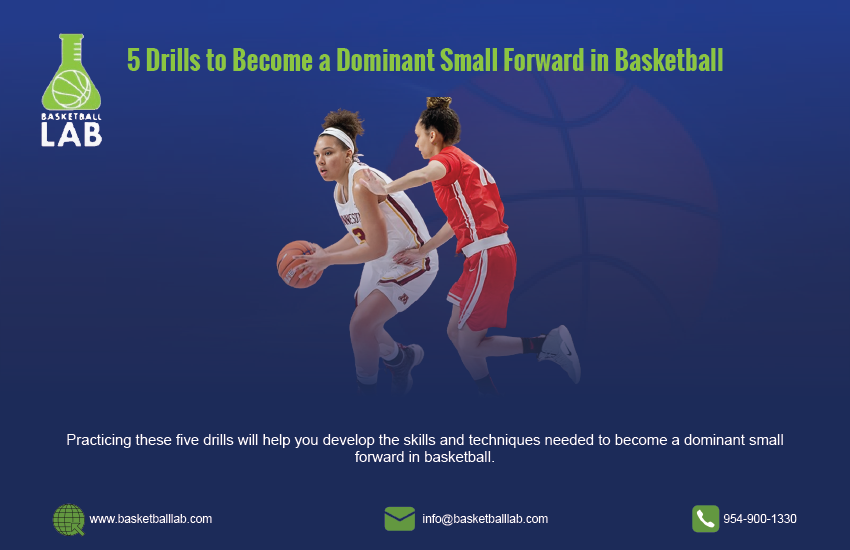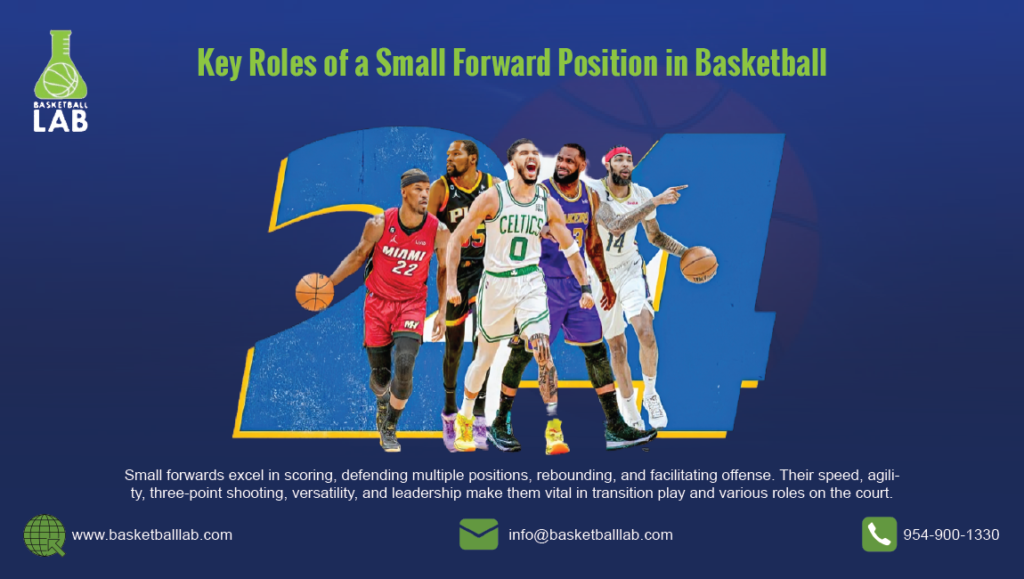The small forward is one of the most important positions in basketball. They have to act as both guards and forwards, simultaneously. Small forwards have to perform many duties on a basketball floor. Their responsibilities range from scoring to shooting, defending, and passing.
Whether you are a basketball fan or a player dreaming of playing for a team in this position. You must have full knowledge about the small forward and his duties. It will facilitate your understanding of the game and help you play much better.
This article gives a detailed understanding of the small forward position. It describes some of the vital skills training drills and features some of the greatest basketball players in the history of the game.

What is the Small Forward Position in Basketball?
The small forward position is also known as the 3 or third position on the basketball court. It is one of the most diverse and useful positions in team formation. Small forwards are usually positioned between the power forward and the point guard in an offense formation,
 Source: playard.sg
Source: playard.sg
Small Forward Position’s primary roles include offense and defense.
In most cases, they are used on the wings, where they utilize quickness, speed, and dribbling to penetrate through the defense. Also, they shoot from the outside and contribute much to their teams.
Facts: According to NBA statistics, the average shooting percentage for small forwards in the NBA is around 45% (Source: Statmuse). Moreover, their three-point shooting percentage is around 35% (Source: Statmuse).

Roles & Responsibilities of a Small Forward in Basketball
Small forwards are required to excel in multiple areas, we’ll highlight some of them here,
- Scoring
- Rebounding
- Defense
- Passing
- Versatility
Scoring
Small Forward must be good from mid-range and beyond the three-point line. Also, they must be excellent at shooting. They should be able to reach the basket in a proper manner. It applies their power and quickness to score a point.
Rebounding
While small forwards are not supposed to be the tallest on the team. They should be aggressive when rebounding, whether on offense or defense.
- Harrison Barnes was the most effective small forward in 2022-23 season with 4.5 Rebounds per Game (Source: Statmuse).
Defense
Small forwards frequently play close to the outside or perimeter scorers of the other team. This needs quick reflexes, strong lateral movement, and an anterior sense of the opponent’s moves.
Passing
Small forwards should also be great passers and movers with good court vision. It helps create space and open shots for their teammates.
Versatility
They are versatile and able to switch between defensive and attacking formations. Therefore, being able to play multiple roles as needed, during different phases of the game.

5 Drills to Become a Dominant Small Forward in Basketball
If you need to emerge as a leading small forward in Basketball, it is essential to introduce certain drills to your workout schedule.
Here are five essential drills you can include in your training regime:
- Shooting Drills
- Spot-Up Shooting
- Pull-Up Jumpers
- Ball-Handling Drills
- Cone Dribbling
- Figure 8 Dribbling
- Defensive Drills
- Closeout Drill
- Rebounding Drills
- Box Out Drill
- Passing Drills
- Partner Passing
1. Shooting Drills
Spot-Up Shooting
Make several attempts of shooting from different positions around the court perimeter to improve your aim and stability.
Pull-Up Jumpers
Work on dribbling into a pull-up jumper to improve your mid-range game.
2. Ball-Handling Drills
Cone Dribbling
Place some cones on the floor and proceed to dribble around the cones in order to improve your dribbling and speed.
Figure 8 Dribbling
Another practice involves dribbling the ball in figure 8 fashion around one’s legs to be able to exercise more control.
3. Defensive Drills
Closeout Drill
Learn how to close out on a shooter to contest his shot while staying in a good defensive position.
4. Rebounding Drills
Box Out Drill
Practice moves like boxing out the opponent and going for rebounds, focusing on timing and positioning.
5. Passing Drills
Partner Passing
Perform various bounces and chest passes with a partner. It helps them develop accuracy and timing in a match.
If you are looking for a way to elevate your game, we suggest you join our “Basketball Lab” training programs. Be it Agility Training, Individual Training, Team Training, or Semi-Private Training, we have the program for you.
Furthermore, our blog article, “Self Training vs. One-on-One Training vs. Group Basketball Training – What’s Better?” will assist you in identifying the most suitable training method for the intended objective.

The Best Small Forwards in NBA History
Several small forwards have left an indelible mark on the NBA, such as:
1. Larry Bird
He was a prolific shooter, a good rebounder, and an excellent scorer. As a leading player in the NBA, Bird has many accomplishments. He won three MVP titles. Also, he helped the Boston Celtics win three NBA championships.
2. LeBron James
LeBron James is 4 time NBA champion, and four time MVP. He is one of the most tactful and wise basketball players that the world has ever seen.
3. Kevin Durant
Durant, in his basketball career, has managed to secure two championships and has been a four-time scoring champion.
4. Scottie Pippen
During his time with the Chicago Bulls, Pippen played an important role for the team that won the title six times; his defensive skills and ability to adapt were also crucial to the team’s success.
Visit Basketball Lab to learn what training programs should be aimed at in order to become a better small forward. Whether you require a One-on-One, Group Setting, or Combined Setting, we have everything you need to be successful.



